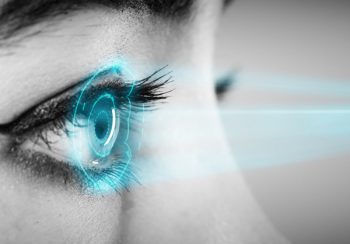Contributing writer for Wake Up World
Myopia, or nearsightedness, causes faraway objects to appear blurry while close-up objects look clear. One of the greatest risk factors for myopia is having a parent who also suffers from this vision problem.1 As such, it’s long been considered a primarily genetic condition — until recently.
Speaking with The Atlantic, Dr. Marina Su, a New York City optometrist, noticed that more children in her practice had declining vision, even though their parents’ vision was perfect. “If it’s only genetics, then why are these kids also getting myopic?” she said.2 Myopia is on the rise worldwide — not just in New York City — and there’s debate over what’s driving the change.
A frontrunner is the theory that technology — particularly staring at screens all day — is the culprit, leading to problems with vision at younger and younger ages, which could lead to “an epidemic of blindness that’s decades down the road,” according to Dr. Michael Repka, an ophthalmology professor at Johns Hopkins University.3
An Epidemic of Myopia
In a report from the Task Force, it’s stated that the prevalence of myopia is expected to grow from 1,406 million people, or 22.9% of the population, in 2000 to 4,758 million people — 49.8% of the population, in 2050.5 Severe nearsightedness, known as high myopia, is also expected to rise, from 163 million people (2.7% of the population) in 2000 to 938 million people (9.8% of the population) in 2050.6
For some populations in Asia, especially university students, myopia prevalence is over 90%.7 Among young adults in East and Southeast Asia, 80% to 90% have myopia and 10% to 20% have high myopia. The tendency to study long hours and perform “near work” with the eyes has long been linked to poor eyesight.8 According to The Atlantic:9
“Historically, British doctors have found myopia to be much more common among Oxford students than among military recruits, and in ‘more rigorous’ town schools than in rural ones. A late-19th-century ophthalmology handbook even suggested treating myopia with a change of air and avoidance of all work with the eyes — ‘a sea voyage if possible.’”
It’s a concerning trend that goes far beyond the inconvenient need to wear glasses. The fact is, the way technology has infiltrated our lives, in many cases from morning until well into the night, has changed the way humans use their eyes dramatically in just a short blip of time.
“Long ago, humans were hunters and gatherers,” Liandra Jung, an optometrist in the Bay Area, told The Atlantic. “We relied on our sharp distance vision to track prey and find ripe fruit. Now our modern lives are close-up and indoors. ‘To get food, we forage by getting Uber Eats,’” she said.”10
Progressive Myopia Carries Significant Risks
According to the AAO Task Force, by age 75, 3.8% of people with myopia and 39% of those with high myopia have “uncorrectable visual impairment.”12 In other words, myopia increases the risk of conditions that can cause permanent blindness, including retinal detachment, cataracts and glaucoma, even when myopia is low to moderate severity.13
The AAO task force explained that the widespread clinical and societal impacts of increasing myopia prevalence require a “coordinated global response,”14 particularly since the younger a person is at onset, the faster progression tends to be.15 AAO added:16
“It is projected that uncorrectable visual impairment resulting from myopia will increase 7 to 13 times in high-risk areas by 2055. The public health burden posed by myopia extends beyond the direct costs associated with the optical correction of refractive error and includes the socioeconomic impacts and diminished qualify of life associated with visual impairment.”
In China, large-scale changes have been implemented to combat the growing trend of myopia in children. Along with restricting video games, no written tests are given before third grade, and metal bars have even been added to school desks so children are forced to stay farther away from their schoolwork.17
Screen Time, Lack of Outdoors to Blame?
Vision is suffering as a result. Writing in the journal Progress in Retinal and Eye Research, a team of experts identified intensive education (i.e., more studying) and limited time outdoors as the major risk factors in the epidemic of myopia.18 They wrote:
“The localization of the epidemic appears to be due to the high educational pressures and limited time outdoors in the region, rather than to genetically elevated sensitivity to these factors.
Causality has been demonstrated in the case of time outdoors through randomized clinical trials in which increased time outdoors in schools has prevented the onset of myopia. In the case of educational pressures, evidence of causality comes from the high prevalence of myopia and high myopia in Jewish boys attending Orthodox schools in Israel compared to their sisters attending religious schools, and boys and girls attending secular schools.
Combining increased time outdoors in schools, to slow the onset of myopia, with clinical methods for slowing myopic progression, should lead to the control of this epidemic, which would otherwise pose a major health challenge. Reforms to the organization of school systems to reduce intense early competition for accelerated learning pathways may also be important.”
AAO also stated, “Too much time spent indoors increases a child’s risk for nearsightedness. Studies show that more time outdoors in natural light reduces a child’s risk.”19 Similarly, French researchers described “outdoor activities” as one of the most promising treatments for myopia in children.20
An alarming increase was further identified in myopia in children in 2020, when home lockdowns occurred, keeping an already nature-starved population indoors even more. One study found that home confinement due to the COVID-19 pandemic was associated with worsening myopia in children. Myopia prevalence among children aged 6 to 8 years increased 1.4 to three times in 2020 compared to the five years prior.21
Another study, published in the American Journal of Ophthalmology, described digital screen time during the COVID-19 pandemic as a “risk for a further myopia boom.” “Increased digital screen time, near work, and limited outdoor activities were found to be associated with the onset and progression of myopia, and could potentially be aggravated during and beyond the COVID-19 pandemic outbreak period,” they wrote in 2021.22
Moving Toward Myopia Control
Treatments include atropine eye drops, multifocal soft contact lenses and orthokeratology lenses (OrthoK), which are worn overnight. OrthoK are contact lenses that reshape the eyeball’s clear, front layer, changing the way light enters the eye and helping to improve vision.24
No treatments are capable of curing myopia, however; they’re only able to slow down its progression. Prevention is a better option, and spending more time outdoors — and far less time on screens — is key for that, especially in young children.
Blue Light Exposure From Screens Also Dangerous
LEDs found in many screens have virtually no beneficial infrared light and an excess of blue light that generates reactive oxygen species (ROS), harming your vision and possibly leading to age-related macular degeneration (AMD),26 which is the leading cause of blindness among the elderly in the U.S. LED lights may also exacerbate mitochondrial dysfunction leading to chronic conditions ranging from metabolic disorders to cancer.
“Although not conclusive, we would advise that the use of blue light emitting devices should be minimized in prepubertal children, especially in the evening when exposure may have the most hormone-altering effects,” Dr. Aylin Kilinç U?urlu said in a news release.
If you view screens at night, it’s therefore essential to block your exposure to blue light while doing so. In the case of your computer, you can install a program to automatically lower the color temperature of your screen. In addition, when watching TV or other screens, be sure to wear blue-blocking glasses after sundown. Better yet, eliminate the use of screens entirely after sunset, particularly in young children who are most susceptible to their deleterious effects.
About the author:
Born and raised in the inner city of Chicago, IL, Dr. Joseph Mercola is an osteopathic physician trained in both traditional and natural medicine. Board-certified in family medicine, Dr. Mercola served as the chairman of the family medicine department at St. Alexius Medical Center for five years, and in 2012 was granted fellowship status by the American College of Nutrition (ACN).
While in practice in the late 80s, Dr. Mercola realized the drugs he was prescribing to chronically ill patients were not working. By the early 90s, he began exploring the world of natural medicine, and soon changed the way he practiced medicine.
In 1997 Dr. Mercola founded Mercola.com, which is now routinely among the top 10 health sites on the internet. His passion is to transform the traditional medical paradigm in the United States. “The existing medical establishment is responsible for killing and permanently injuring millions of Americans… You want practical health solutions without the hype, and that’s what I offer.”
Visit Mercola.com for more information, or read Dr. Mercola’s full bio and resumé here.

If you've ever found value in our articles, we'd greatly appreciate your support by purchasing Mindful Meditation Techniques for Kids - A Practical Guide for Adults to Empower Kids with the Gift of Inner Peace and Resilience for Life.
In the spirit of mindfulness, we encourage you to choose the paperback version. Delve into its pages away from screen glare and notifications, allowing yourself to fully immerse in the transformative practices within. The physical book enriches the learning process and serves as a tangible commitment to mindfulness, easily shared among family and friends.
Over the past few years, Wake Up World has faced significant online censorship, impacting our financial ability to stay online. Instead of soliciting donations, we're exploring win-win solutions with our readers to remain financially viable. Moving into book publishing, we hope to secure ongoing funds to continue our mission. With over 8,500 articles published in the past 13 years, we are committed to keeping our content free and accessible to everyone, without resorting to a paywall.








